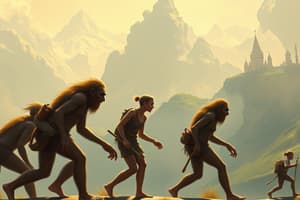Podcast
Questions and Answers
What does the study published in Nature suggest about the relationship between Denisovans and Homo juluensis?
What does the study published in Nature suggest about the relationship between Denisovans and Homo juluensis?
The study suggests that Denisovans may not represent a separate species but rather a population within the Homo juluensis lineage.
What factors contributed to the extinction of Homo juluensis according to the study?
What factors contributed to the extinction of Homo juluensis according to the study?
Homo juluensis likely faced extinction due to environmental challenges and competition with modern humans.
How does the study change the understanding of human evolution in eastern Asia?
How does the study change the understanding of human evolution in eastern Asia?
The study suggests that there is greater diversity among ancient populations in eastern Asia than previously understood.
What implications do the findings about Homo juluensis have on existing models of human evolution?
What implications do the findings about Homo juluensis have on existing models of human evolution?
What is significant about the variety of fossils discovered in relation to Homo juluensis?
What is significant about the variety of fossils discovered in relation to Homo juluensis?
What are the distinctive physical traits of the newly discovered Homo juluensis?
What are the distinctive physical traits of the newly discovered Homo juluensis?
What role did the environment play in the adaptation of Homo juluensis?
What role did the environment play in the adaptation of Homo juluensis?
What evidence suggests that Homo juluensis had a highly adaptive lifestyle?
What evidence suggests that Homo juluensis had a highly adaptive lifestyle?
How did the population dynamics of Homo juluensis contribute to their vulnerability?
How did the population dynamics of Homo juluensis contribute to their vulnerability?
What similarities did Homo juluensis share with Denisovans?
What similarities did Homo juluensis share with Denisovans?
What timeline does the existence of Homo juluensis align with in terms of human evolution?
What timeline does the existence of Homo juluensis align with in terms of human evolution?
How might the migration of modern humans out of Africa have impacted Homo juluensis?
How might the migration of modern humans out of Africa have impacted Homo juluensis?
What significance do the findings about Homo juluensis have for understanding human evolution?
What significance do the findings about Homo juluensis have for understanding human evolution?
Flashcards
Homo juluensis
Homo juluensis
A newly discovered human species that lived in China approximately 200,000 years ago.
Human Evolution
Human Evolution
The process of change in human species over time.
Xujiayao site
Xujiayao site
The location in China where the fossils of Homo juluensis were discovered.
Large Skulls and Teeth
Large Skulls and Teeth
Signup and view all the flashcards
Adaptive Lifestyle
Adaptive Lifestyle
Signup and view all the flashcards
Specialized Diet
Specialized Diet
Signup and view all the flashcards
Small, Isolated Groups
Small, Isolated Groups
Signup and view all the flashcards
Late Quaternary
Late Quaternary
Signup and view all the flashcards
Denisovans
Denisovans
Signup and view all the flashcards
Late Quaternary period
Late Quaternary period
Signup and view all the flashcards
Genetic mixing
Genetic mixing
Signup and view all the flashcards
Human evolution complexities
Human evolution complexities
Signup and view all the flashcards
Study Notes
New Human Species Discovered in China
- Scientists identified a new human species, Homo juluensis, in China.
- Fossils of 16 individuals were found at the Xujiayao site.
- Homo juluensis lived approximately 200,000 years ago.
- Distinctive features include large skulls (103-109 cubic inches), wide craniums, and oversized teeth.
- These traits differentiate Homo juluensis from Neanderthals and modern humans (whose skulls are 88 and 82 cubic inches, respectively).
Adaptations and Lifestyle
- Homo juluensis exhibited a sophisticated adaptive lifestyle, evidenced by tools, artifacts, and animal bones.
- The species were skilled hunters, primarily of wild horses, consuming every part of the animal.
- They crafted clothing from animal hides, suggesting adaptations to harsh environments.
Relationship to other Hominins
- Homo juluensis is not directly related to Neanderthals but shares dental similarities with Denisovans.
- Both Homo juluensis and Denisovans have unusually large molars with almost identical biting surfaces.
- This suggests possible lineage connection; Denisovans may have been a population within the Homo juluensis lineage, rather than a distinct species.
Extinction Factors
- The species likely emerged through interbreeding with early humans.
- Homo juluensis extinction resulted from environmental challenges, climate change and intense competition with modern humans.
- Small, isolated groups of Homo juluensis made them more vulnerable.
Implications
- Homo juluensis adds to the understanding of greater diversity in ancient populations of eastern Asia.
- Its discovery challenges previously held models of human evolution.
- The fossils from eastern Asia surpass expectations and increase the complexity of human evolution research.
Studying That Suits You
Use AI to generate personalized quizzes and flashcards to suit your learning preferences.





